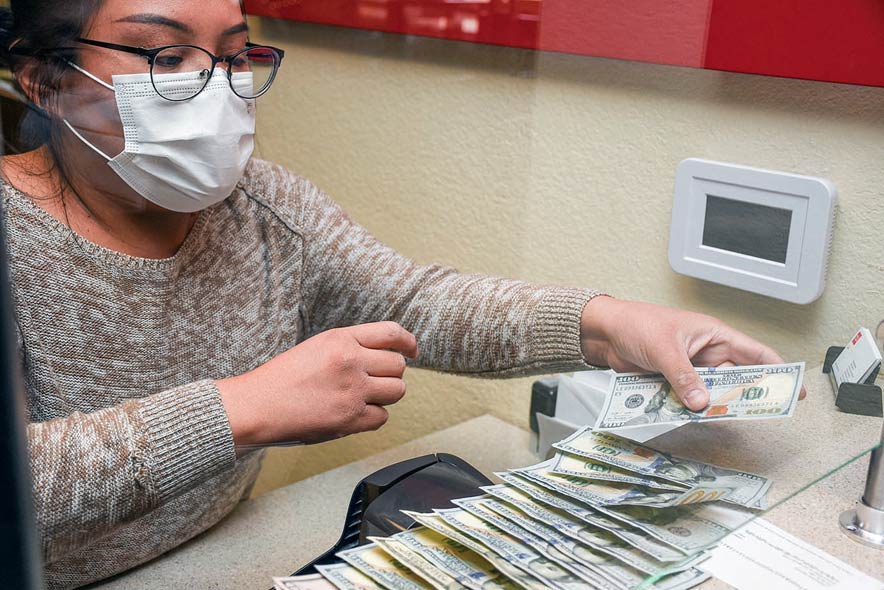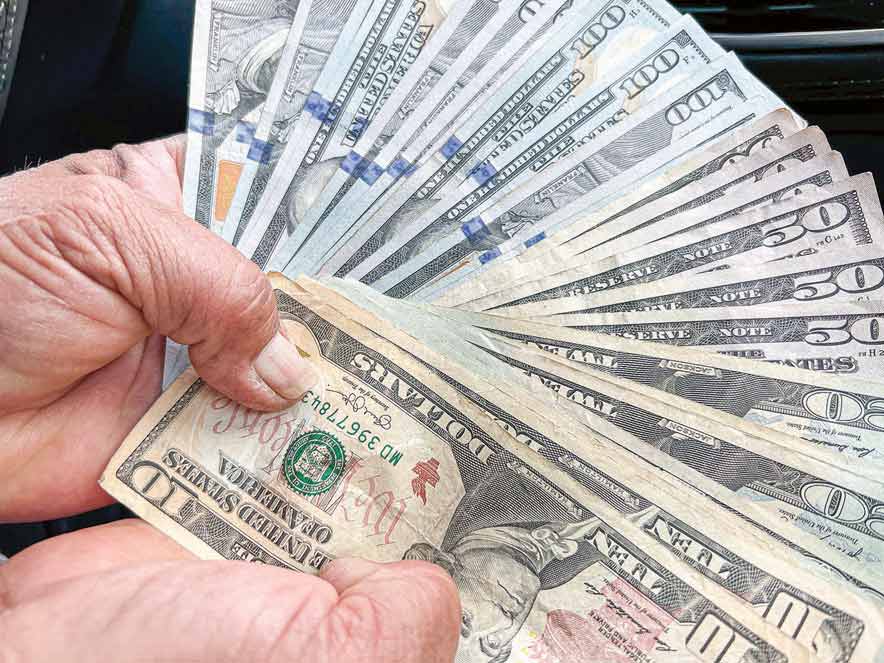
Hardship checks going out, bank staff prepares

Navajo Times | Krista Allen
Maya Begay, a teller at the Wells Fargo bank in Tuba City counts 15 $100 bills for a customer who cashed her ARPA Hardship Assistance check on Thursday, March 3.
TÓNANEESDIZÍ and TSÉBIGHÁHOODZÁNÍ
When Chantel Yazzie gets her hardship check, she’s going to pay off her Jeep Wrangler.
She uses her Jeep to commute to work and go off-roading after stopping for a pickle and a Slush Puppie or a Piccadilly at one of the Tuba City convenience stores.
She has a $3,000 balance left to pay off her auto loan.
Yazzie, who’s a young adult, could receive her ARPA Hardship Assistance check sometime next week. Her check could be in the mix of the thousands of hardship checks sent out on Monday, March 7.
This batch of hardship checks is for persons under 60 years old.
“Those are continuous,” President Jonathan Nez said in an interview on Tuesday. “The (controller’s) team worked again Saturday. A large (number) of checks should have been printed, put into envelopes, and sent out on Monday.”
Checks for elders
Late last month, the controller’s office finished sending the ARPA hardship checks to about 46,000 men and women 60 and older who also received the CARES Fund Hardship Assistance checks for $342.
The controller’s office prioritized checks for older adults. Payments automatically went to people who received help in either 2020 or 2021 under a separate relief program called the Navajo Nation CARES Fund Hardship Assistance.
Releasing checks to older adults first stems from Diné teachings centered on respecting elders, said Nez.
“I appreciate the Navajo citizens for supporting that,” he said. “During the CARES Act, we gave them $342 just to get them through some of this hardship. We announced that we’re going to (send) the ARPA (checks for) $2,000 to our elders.
“We honor our elders,” he added. “We lost some of our elders during the pandemic. Our prayers go out to those families, and we’re a Nation that thinks of our elders and our most vulnerable population. That’s why we still have the mask mandate. We take this pandemic very seriously.”
Nez said older Diné men and women are the keepers of Diné history, teachings, culture, especially the Navajo language.
“We appreciate the Navajo people supporting that,” Nez said. “I heard comments – ‘Elders first. We young people can wait.’
“And I appreciate the patience,” he said, “but now we’ve got most of the elders their hardship check, the under-60 will be getting theirs.”
Sending checks is no small logistical feat, said Nez. But that doesn’t mean it will go smoothly for everyone, especially the team working weekends and on holidays at the controller’s office, in the coming weeks.
Busy tellers

Navajo Times | Krista Allen
A woman fans out $2,000 after cashing her ARPA Hardship Assistance check at Wells Fargo in Tuba City on Thursday, March 3. The bank asked the Navajo Times to safeguard customer identity unless the customer was OK with being photographed.
Her staff prepared when Araceli Hinojosa’s Four Corners team learned that the Wells Fargo branches in the North Mountain District would be busy assisting older customers first.
Hinojosa said it takes communication to manage hundreds of customers every day.
“Communication is central because there’s a lot of moving parts,” explained Hinojosa, the regional banking district manager for Wells Fargo’s North Mountain District. “We have to keep an eye on all of them to make sure that (mistakes) aren’t made because we’re dealing with a lot of money and customers’ accounts.
“We want to get it right the first time,” she said. “That takes organization, prioritization, and planning.”
Hinojosa said she and her Four Corners team had to plan and rally together before the hardship checks were released. The communication involved talking with leaders and the postal service, which would give the Wells Fargo branch managers in the Nation a heads up when checks would show up at the post office.
“Everybody pulls together,” Hinojosa said. “How can we communicate and be best available and welcoming when those checks do come in?”
Hinojosa said this year was a little different assisting people with their hardship checks compared to the two previous years when the hardship checks from the tribe were released all at once.
“This has been a little more staggering, which has been more helpful,” Hinojosa explained. “But the communication with the team, we need two to three times a week to ensure that we’re discussing what went well, what can we continue to do, how can we communicate better.”
Her team members also wanted to do something special to honor the older people who’d be cashing their hardship assistance checks at the Wells Fargo branches in Diné Bikéyah.
The Chinle branch team members decided to dress in their traditional outfits and wear their kélchí, béésh ?igaii and doot?’izhí, such as látsíní, sis ?igaii, and yoo’ názhahí/nimazí.
“They wanted to dress traditionally,” Hinojosa said. “So, that we could be there for them. Our elders like that. I said, ‘Let’s do it.’ And they did.
“It was just awesome to see them and the smiles,” she said. “I’d introduce myself in Navajo and (the elders) would come in and they appreciated that. It was kind of like a little party, welcoming them in. We wanted to be prepared. I think it’s the pride.”
Cash amounts, customers
Hinojosa said she and her team review staff and branch cash amounts consistently to ensure there’s enough money to exchange daily.
“There’s a lot of moving parts, but communication, organization, and prioritization (are) what helps us to be successful,” she said.
“We look forward to getting cash into (customers’) hands,” she said. “We did this last year too, and we were really busy. We had a lot of key learning from that experience that we implemented into this go-round.
“I think this go-round has been really good with our employees just excited to help, especially our elders,” she added. “When we heard that the checks for (older people) were coming first, that was exciting because we don’t see them all the time. So, to see them in the branches, that’s special.”
Because stay-at-home orders halted travel for many older Diné men and women, tellers and bankers didn’t see many elders inside the bank.
“We talk about this every day,” said Ron Yazzie, branch manager for Wells Fargo in Window Rock. “For me and my employees, we love working for our community members. We love to see our elderly customers.
“We usually see them on the first of every month,” he said, “and we cherish that time. Now, we’re able to see them more often.”
Yazzie said he saw many of the older people return to the Window Rock branch for the first time since the pandemic started in March 2020.
“I’m really glad to see them now in this pandemic,” he said. “A lot of them we couldn’t see because they were (sheltering) at home. We’re happy to see them. Some of them want to hug us. We love it! I love it!”
Kes Seweingyawma, branch manager for Wells Fargo in Tuba City, said she and her team work hard to help the communities in northwestern Navajo because there is only one Wells Fargo bank that serves the area.
“At the end of the day, it’s a positive feeling because we’re helping so many people,” she said. “This effort is exciting because they (elders) receive this money from the Navajo Nation, and it helps them financially.
“We get a lot of people grateful that they can come here and cash their checks,” she added. “We also see a lot of non-account holders too. You kind of lose track of the day because we’re so focused on helping the customers, creating a positive, welcoming environment for them, especially during the busy times.”
Seweingyawma said Yazzie and the postmaster in Tuba City often inform her of incoming checks so she and her team can prepare for a busy day.
“The team’s been great and excited about this effort,” she added. “They really do their best to assist community members when they arrive with the checks. We are ready to serve the community.”
As a public service, the Navajo Times is making all coverage of the coronavirus pandemic fully available on its website. Please support the Times by subscribing.
How to protect yourself and others.
Why masks work. Which masks are best.
Resources for coronavirus assistance








 Highway 264,
Highway 264, I-40, WB @ Winslow
I-40, WB @ Winslow